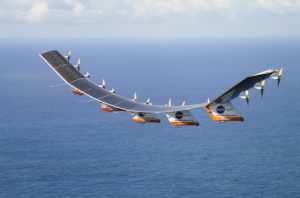High Altitude, Long Endurance (HALE) drones have a set of commercial applications which differ significantly from those performed by standard quadcopters. Often looking like something out of a science fiction movie, HALE UAVs have grand ambitions – like providing internet coverage to the entire globe, or cell phone coverage in places where it is now unavailable. The impact that this type of aircraft could have on communities is incredible – imagine the lives that could be saved with a communication network that might not fail during a land-based natural disaster like an earthquake or hurricane, or the potential economic benefit to remote areas of the world currently without reliable internet access.
The “long endurance” part of a HALE UAV isn’t measured in hours or even days. HALE aircraft are designed to stay in flight perhaps for years without requiring fuel. That means that solar power is a critical component of the design. While both Facebook and Google have tried to develop solar-powered HALE devices, energy company Alta Devices may actually have succeeded.
The following is taken from an Alta Devices press release.
Alta Devices (www.altadevices.com) today announced a new solar solution that is designed to meet the specific needs of unmanned aerial vehicles (UAV) that can serve as platforms for cellular and IoT connectivity. By combining its breakthrough solar cell technology with several new inventions, this solution offers industry-leading features to maximize power, minimize weight, and provide sufficient protection from the harsh environment commonly found in the Earth’s stratosphere (60,000 feet).
High altitude long endurance (HALE) UAVs that fly at stratospheric levels (sometimes also referred to as high altitude pseudo satellites (HAPS)), are an important new aircraft category and can include airplanes, airships, and/or balloons that can fly at altitudes of 20 kilometers (60,000 feet) for extended periods of time. In addition to being used for a variety of communications (such as cell phone connectivity and others), these aircraft can be used for intelligence surveillance and reconnaissance (ISR), search and rescue, border patrol, mapping, and many other applications. Solar power is critical for these aircraft, particularly because the objective is to fly for years without refueling.
Miriam McNabb is the Editor-in-Chief of DRONELIFE and CEO of JobForDrones, a professional drone services marketplace, and a fascinated observer of the emerging drone industry and the regulatory environment for drones. Miriam has a degree from the University of Chicago and over 20 years of experience in high tech sales and marketing for new technologies.
Email Miriam
TWITTER:@spaldingbarker
Subscribe to DroneLife here.
https://dronelife.com/2019/04/23/flying-cell-phone-towers-with-solar-drones-yes-really/
